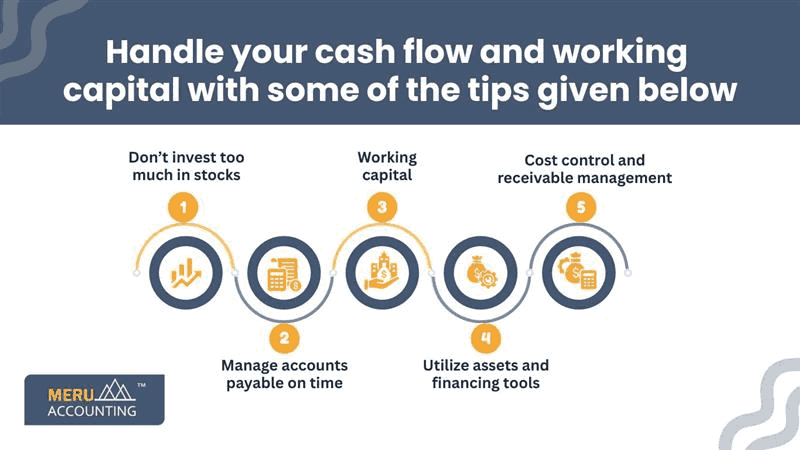
Looking to better manage your cash flow and working capital?
Cash flow statement tips help you track how money moves in and out of your business. These tips make it easier to manage cash and maintain good working capital. Efficient cash management is necessary for the survival of any business. It helps business owners to understand the inflow and outflow of money as income and expenses. It helps in making important investment decisions for the growth of the business. It is vital for SMEs and startups, especially, to keep their business running in these competitive markets.
Good working capital management helps improve a business’s finances. It gives owners room to cover surprise costs and invest in new ideas. This article will guide you with simple cash flow statement tips. It will help you understand your cash flow financial statement and improve your working capital.
What Is a Cash Flow Statement?
A cash flow statement shows the cash coming in and going out of a business. It is considered one of the most important financial documents for any business. This statement helps track actual money movement. It differs from both the income statement and the balance sheet.
There are three main parts of a cash flow statement:
- Operating Activities: Displays the cash generated or used through regular business operations.
- Investing Activities: Tracks money spent on equipment, buildings, or investments.
- Financing Activities: Covers loans, equity, and repayments.
Using the cash flow financial statement helps in making smart financial decisions.
Handle your cash flow and working capital with some of the tips given below
Business owners can take simple steps to improve cash flow and working capital. These actions help make their company more stable.
Some key tips to manage cash flow and working capital include:
1. Working capital
- Business owners often think of working capital as work associated with the finance team.
- They must have KPIs for working capital that are understandable by the management team.
- Everyone needs to be aware of KPIs and know-how and why it is necessary to manage working capital.
- Part of what helps improve better decisions and a balanced approach to cash flow management is when the whole business is aware of how working capital is measured and managed.
- These are important Cash Flow Statement Tips that influence the cash flow statement and overall cash flow financial statement of the company.
2. Manage accounts payable on time
- When you pay suppliers on time, you don’t have to chase invoices; it will help in getting flexibility in prices and business terms.
- You can effectively negotiate with suppliers and can charge a particular person for maintaining a healthy business relationship.
- On-time payments will also save you the time used to chase the invoices, which will give you more room to negotiate with suppliers.
- This builds a strong reputation. You may also get better terms, which can improve your cash flow statement and cash flow financial statement.
- It's one of the practical Cash Flow Statement Tips businesses can adopt.
3. Don’t invest too much in stocks
- Excessive stock holdings block a substantial amount of capital.
- Overbuying of stock can be avoided by monthly or quarterly stock checking, while also ensuring no shortage.
- Thus, one needs to maintain the balance between excessive and shortage concerns.
- Keeping a clear balance is key to managing working capital well. It also enhances the overall cash flow financial statement.
- One of the top Cash Flow Statement Tips is monitoring inventory closely to support a better cash flow statement.
4. Utilize assets and financing tools
- Businesses can secure long-term finances against assets such as plants and equipment etc.
- Businesses can opt for quicker repayment to cut interest or longer terms to lower monthly payments.
- This helps meet financial needs without affecting working capital and supports growth.
- Asset-backed financing improves liquidity reflected in the cash flow statement and ensures a healthy cash flow financial statement.
- It's among the key Cash Flow Statement Tips used for financial stability.
5. Cost control and receivable management
- Invoice factoring and discounting free up cash stuck in accounts receivable. Businesses can borrow up to 85% of the invoice amount.
- It also reduces the burden of collecting payments and ensures liquidity for operations.
- Controlling costs through set expense rules and tools like corporate cards supports better cash management.
- These practices positively affect the cash flow financial statement and improve the cash flow statement.
- Combined, they form actionable Cash Flow Statement Tips to maintain business health.
Tools to Manage Cash Flow
Use tools that show real-time data. These help you track cash more easily:
- Accounting Software: QuickBooks, Xero
- Spreadsheets: Google Sheets or Excel
- Cash Flow Dashboards: Custom dashboards in tools like Zoho or FreshBooks
Keep these tools updated with the latest data. Use these tools to keep your cash flow statement and cash flow financial statement up to date.
Conclusion
Managing cash flow and working capital effectively plays a key role in the growth of the business. Follow the cash flow statement tips shared in this article. Review your cash flow statement often. A strong cash flow statement helps you stay ready for upcoming opportunities. Use the tips to keep your business stable, efficient, and profitable.
Cash flow and working capital management determine the sustainability of a business or organization. Accounts Junction has a dedicated team of CPAs, CAs, and accountants. We use the latest cloud technology so our clients can focus on their business while we handle the accounting.
Accounts Junction will assist you in keeping your books and accounting up to par so that your business remains healthy and prosperous.
FAQs
1. What is a cash flow statement?
A cash flow statement shows your income and spending in cash form.
2. How frequently should I assess my cash flow?
Review it weekly or monthly depending on your business size.
3. Can cash flow be positive but profits low?
Yes, you can have cash but still show low profits due to accounting methods.
4. How does cash flow help in decision-making?
It indicates whether you have enough cash to invest or settle expenses.
5. What is working capital?
Working capital is the gap between what you own and what you owe in the short term.
6. What tools can assist in tracking cash flow?
Use tools like QuickBooks, Zoho, or Excel.
7. How can I tell if my cash flow is healthy?
Check if your operating activities consistently show positive cash flow.

